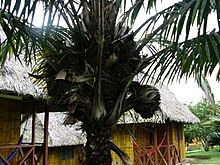Corozo Palms
| Corozo Palms | ||||||||||||
|---|---|---|---|---|---|---|---|---|---|---|---|---|

Infructescence of a Phytelephas macrocarpa |
||||||||||||
| Systematics | ||||||||||||
|
||||||||||||
| Scientific name | ||||||||||||
| Phytelephas | ||||||||||||
| Ruiz & Pav. |
The coconut palms or ivory palms ( Phytelephas ) are a genus in the palm family (Arecaceae). The endosperm of their seeds is used as vegetable ivory .
features
The corozo palms are medium to large diocese palms. The only trunk is upright. The leaf bases are often retained on the trunk, and one or more dead leaves are usually attached to the trunk. The leaves are pinnate, divided regularly. The leaf sheath is open and has brown fibers on the edge. The petiole is concave in cross section. The leaflets are set regularly or in groups. The nerves protrude easily. The tip of the leaflets is symmetrical and narrows evenly.
The inflorescence has several pendulous bracts. The male inflorescences are cylindrical, yellow and have densely packed flowers. These have an inconspicuous inflorescence and numerous stamens . The female inflorescences are compact and have fewer than 25 flowers. Each flower has three or more triangular sepals , four to ten petals and an ovary made of four to ten fused carpels.
The fruit stands are spherical. The fruits are large and covered with corky, thorn-like growths. The leaves of the seedlings are pinnate.
The chromosome number is 2n = 36.
Distribution and location
The representatives of the genus are common in South and Central America . They prefer moist, shady locations.
use
The fruits have an endosperm that becomes about as hard as bones after drying. This is used as a raw material to replace ivory , for example for carving (see corozo ).

Systematics
The genus Phytelephas Ruiz & Pav. Is placed within the family Arecaceae in the subfamily Ceroxyloideae , tribe Phytelepheae . The genus is monophyletic . Her sister group is the group of Ammandra and Aphandra .
In the World Checklist of Selected Plant Families of the Royal Botanic Gardens, Kew , the following types are recognized:
- Phytelephas aequatorialis Spruce : The homeland is western Ecuador.
- Corolla nut palm ( Phytelephas macrocarpa Ruiz & Pav. , Syn .: Phytelephas schottii H. Wendl. , Phytelephas seemannii O.F. Cook ): It occurs from Panama to Bolivia and northwestern Brazil.
- Phytelephas tenuicaulis (Barfod) HJHend. : The homeland is southern Colombia, Ecuador and northern Peru.
- Phytelephas tumacana O.F.Cook : The home is the province of Nariño in southwestern Colombia.
The genus Phytelephas was established by the two Spanish botanists Hipólito Ruiz López and José Antonio Pavón y Jiménez ; their description was published in 1798 in their joint work Systema vegetabilium florae peruvianae chilensis . Synonyms for the genus are Elephantusia Willd. , Palandra O.F.Cook and Yarina O.F.Cook .
Individual evidence
- ↑ a b c Phytelephas ( Memento of October 10, 2007 in the Internet Archive ) on Palms of Ecuador ( Memento of September 29, 2011 in the Internet Archive )
- ^ A b John Dransfield, Natalie W. Uhl, Conny B. Asmussen, William J. Baker, Madeline M. Harley, Carl E. Lewis: Genera Palmarum. The Evolution and Classification of Palms . Second edition, Royal Botanic Gardens, Kew 2008, ISBN 978-1-84246-182-2 , pp. 351ff.
- ↑ a b c d e Rafaël Govaerts (Ed.): Phytelephas. In: World Checklist of Selected Plant Families (WCSP) - The Board of Trustees of the Royal Botanic Gardens, Kew . Retrieved August 4, 2018.
- ↑ Syst. Veg. Fl. Peruv. Chil .: 299 (1798).